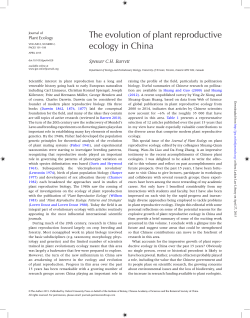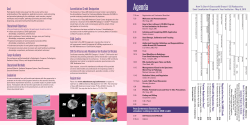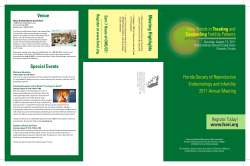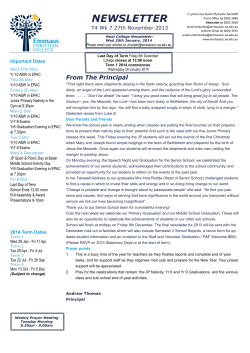
Reproductive Ecology of Flowering Plants: A Manual
Reproductive Ecology of Flowering Plants: A Manual K.R. Shivanna Rajesh Tandon Reproductive Ecology of Flowering Plants: A Manual K.R. Shivanna Ashoka Trust for Research in Ecology and the Environment (ATREE) Bengaluru, Karnataka India Rajesh Tandon Department of Botany University of Delhi Delhi, India ISBN 978-81-322-2002-2 ISBN 978-81-322-2003-9 (eBook) DOI 10.1007/978-81-322-2003-9 Springer New Delhi Heidelberg New York Dordrecht London Library of Congress Control Number: 2014947466 © Springer India 2014 This work is subject to copyright. All rights are reserved by the Publisher, whether the whole or part of the material is concerned, specifically the rights of translation, reprinting, reuse of illustrations, recitation, broadcasting, reproduction on microfilms or in any other physical way, and transmission or information storage and retrieval, electronic adaptation, computer software, or by similar or dissimilar methodology now known or hereafter developed. Exempted from this legal reservation are brief excerpts in connection with reviews or scholarly analysis or material supplied specifically for the purpose of being entered and executed on a computer system, for exclusive use by the purchaser of the work. Duplication of this publication or parts thereof is permitted only under the provisions of the Copyright Law of the Publisher’s location, in its current version, and permission for use must always be obtained from Springer. Permissions for use may be obtained through RightsLink at the Copyright Clearance Center. Violations are liable to prosecution under the respective Copyright Law. The use of general descriptive names, registered names, trademarks, service marks, etc. in this publication does not imply, even in the absence of a specific statement, that such names are exempt from the relevant protective laws and regulations and therefore free for general use. While the advice and information in this book are believed to be true and accurate at the date of publication, neither the authors nor the editors nor the publisher can accept any legal responsibility for any errors or omissions that may be made. The publisher makes no warranty, express or implied, with respect to the material contained herein. Printed on acid-free paper Springer is part of Springer Science+Business Media (www.springer.com) Foreword Tropical countries, including India, are rich in biodiversity with a high incidence of endemism. For the sake of short-term gains, vast areas of wilderness have been destroyed. However, the sustainability of whatever biodiversity is still available in various ecosystems is seriously threatened by continuing human need. Unless effective measures are taken to salvage biodiversity, a large number of species would become irretrievably lost. According to some conservation biologists, we are soon heading towards the sixth mass extinction in evolutionary history. Successful reproduction is the basis not only for the stability of the species in their natural habitat but also for the productivity of our crop plants on which humans and their domesticated animals are dependent. Studies on reproductive ecology are, therefore, important for the effective management of our dwindling biodiversity and improvement of yield in the crop plants. Unfortunately, knowledge of reproductive ecology of wild and crop species in the developing countries is meagre. This constitutes a major limitation that hampers our efforts to conserve biodiversity and optimize crop yields and animal production. Contrastingly, there is enormous information available on reproductive ecology of wild and cultivated species growing in countries with developed economies. Therefore, they have been able to manage their biodiversity and optimize crop yields in a substantial way than their counterparts in developing nations. Also because of the availability of baseline data on reproductive ecology on their plant resources, most of their present studies on reproductive ecology are aimed at formulating hypotheses, testing their validity and preparing mathematical models on reproductive events. Tropical countries do not have even the baseline data on most of the species. Therefore, there is urgent need to initiate and emphasize research on reproductive ecology in tropical countries, where population pressure is acute and malnutrition is rampant, for effective management of biodiversity and to improve the yield and nutritional quality of the crops. One of the limitations of initiating research in this area is lack of mentors and more importantly authentic manuals to motivated and enterprising young plant biologists for conducting research on various aspects of reproductive ecology. Reproductive Ecology of Flowering Plants: A Manual is the first attempt in this direction. K.R. Shivanna and Rajesh Tandon have been working in this field throughout their research careers. This handbook covers the total range of reproductive ecology starting with a thorough study of plants and sites of their occurrence, phenology, breeding system, record of v Foreword vi reproductive events including dispersal of diaspores and ending with seed viability, dormancy and finally seedling recruitment, the ultimate step in the sustainability of populations. This manual will be extremely useful to those who are residing in areas with rich flora but lacking in essential laboratory facilities. I am confident that the manual would encourage the younger generation to take up research in this important discipline of production and utilization of plant resources. Sriram Institute for Industrial Research Delhi, India 6 June 2014 H.Y. Mohan Ram Preface The stability of any species in its natural habitat is dependent on its successful reproduction and recruitment of new individuals to sustain populations. Erosion of biological diversity is one of the most challenging issues of our times. Although overexploitation, habitat destruction and climate change are the proximate causes for erosion of biological diversity, the ultimate driving force for pushing any species to endangered category is its inability to produce enough number of seeds and to recruit new individuals to sustain populations. Tropical countries are rich in biodiversity with a high proportion of endemic elements, and presently many plant species in tropical rain forests are at maximum risk of reproductive failure. One of the major problems in conservation and management of tropical forests is lack of baseline data on their reproductive ecology. This is particularly true for a large number of endemic, endangered and economically important species. This lack of knowledge is largely because very few laboratories in tropical countries, particularly in south and south-east Asia, are working on reproductive ecology. In the absence of such data, any conservation efforts are arbitrary and remain ineffective. Therefore, it is necessary to initiate extensive studies on reproductive ecology of our plants as a requirement for their effective conservation and sustainable utilization. Also, in most of our crop plants, fruits and seeds are the economic products and any constraint in reproduction reduces their production. For sustenance and improvement of yield in the crop species, an understanding of reproductive ecology is an essential prerequisite. Thus, reproductive ecology has direct relevance to conservation biology, agri-horticulture, forestry and plant breeding. Several workshops and training programmes conducted in India during the last few years on reproductive ecology have shown an enormous enthusiasm amongst young researchers to initiate research. A major limitation for the beginners to take up research is absence of simple work manuals that provide the basic steps used in studying reproductive ecology. A few manuals available so far deal largely with pollen biology and pollination biology, and there is no manual covering the whole spectrum of reproductive ecology including seed biology, seed dispersal and seedling recruitment which are important in sustaining the populations and species in their natural habitat. The major aim of this manual is to fill this void and provide the essential working steps involved in studying all aspects of reproductive ecology. The intention is to keep the volume small, and therefore the methods described have been selective (based on the need and our own experience) and does not vii Preface viii aim to give a monographic coverage of all the available techniques. Each chapter gives a concise conceptual account of the topic before describing the protocols. Important relevant references are cited to help the user to get more theoretical information in the subject. The manual covers over 60 protocols. Each protocol lists special requirements followed by detailed working steps so that the researchers do not find any difficulty in conducting investigations. Appendices provide the details of preparation of fixatives, stains and a few other relevant requirements. Most of the protocols presented in the manual require minimum facilities which are generally available in colleges, university departments and research institutions. This is important since most of the biodiversity in developing countries in the tropics is located where only a limited number of well-established laboratories are present. The manual caters to teachers, students and researchers who deal at any level of reproductive ecology of flowering plants – botanists, zoologists, entomologists, ecologists, agri-horticulturists, foresters, plant breeders and conservation biologists. We hope that this manual would stimulate youngsters to undertake studies on reproductive ecology and generate useful data over the years which would be invaluable for conservation and management of our plant diversity. We are grateful to Prof. H. Y. Mohan Ram, for his collaboration in some of our studies on reproductive ecology over the years, encouragement throughout our career and also for writing the foreword for the manual. We sincerely thank Prof. N. S. Rangaswamy for encouragement and counsel, which have been invaluable. Palatty Allesh Sinu, Department of Animal Science, Central University of Kerala, Kasaragod, has critically gone through the chapters on seed dispersal and seedling recruitment. We express our indebtedness to him. Dr. Mamta Kapila, Publishing Editor, Springer (India) Pvt. Ltd., took special interest in the publication of this manual. We are appreciative of the tremendous help extended by Priyanka Khanduri, Yash Mangla, Vineet Kr. Singh, Kadambini, Chandan Barman, Divya Mohanty, Anjali Chaudhary, Remya Krishnan and Banisha Phukela, research scholars at the Department of Botany, University of Delhi, during the finalization of the manual. We specially thank Dr. Milind M. Sardesai and Dr. Vishnu Bhat for providing some of the photographs. KRS thanks the Indian National Science Academy for the award of positions as INSA Senior Research Fellow (2003–2008) and INSA Honorary Scientist (2009–to date), and the Ashoka Trust for Research in Ecology and the Environment (ATREE), Bengaluru, for providing facilities. It is a pleasure to thank Giby Kuriakose and Manju Vasudevan Sharma who were associated with research activities of KRS during the past 10 years. Bengaluru, India Delhi, India K.R. Shivanna Rajesh Tandon Contents 1 Introduction .................................................................................... 1.1 Reproductive Ecology and Conservation Biology ................ 1.2 Reproductive Ecology and Crop Productivity ...................... 1.3 Reproductive Ecology and Release of Transgenics .............. 1.4 Some General Guidelines on Protocols ................................ 1.4.1 Familiarity with Study Plants, Study Sites and Relevant Literature ........................................... 1.4.2 Special Requirements ............................................. 1.4.3 Sample Size ............................................................ 1.4.4 Stage of Flower Buds .............................................. 1.4.5 Temporal Details of Observations and Fixations ........................................................... 1.4.6 Recording of Data ................................................... 1.4.7 Photography ............................................................ 1.4.8 Statistical Analyses ................................................. References ........................................................................................ 1 2 4 6 7 8 9 9 9 9 2 Study Plants and Sites ................................................................... 2.1 Labelling of Plants and Flowers............................................ 2.2 Isolation of Flowers, Inflorescences and Plants .................... 2.3 Field Kit ................................................................................ References ........................................................................................ 13 14 14 16 17 3 Phenology ........................................................................................ 19 3.1 Population Phenology ........................................................... 20 3.2 Floral Phenology ................................................................... 20 3.3 Community Phenology ......................................................... 21 3.4 Protocols ............................................................................... 21 3.4.1 Phenology of Populations ....................................... 21 3.4.2 Phenology of Flowers ............................................. 22 References ........................................................................................ 23 4 Floral Morphology and Sexuality ................................................. 4.1 Morphology of Flower .......................................................... 4.2 Sexuality of Flowers, Plants and Populations ....................... 4.3 Cryptic Sexuality .................................................................. 4.4 Reproductive Allocation ....................................................... 7 8 8 8 25 25 27 29 29 ix Contents x 4.5 Protocols ............................................................................... 30 4.5.1 Morphology of Flower ............................................ 30 4.5.2 Sexuality of Flowers, Plants and Populations ......... 31 4.5.3 Identification of Cryptic/Functional Sexuality ....... 32 References ........................................................................................ 33 5 6 Pollen Biology ................................................................................. 5.1 Pollen Production .................................................................. 5.2 Pollen Fertility and Viability ................................................. 5.3 Pollen Vigour ........................................................................ 5.4 Pollen Morphology ............................................................... 5.5 Protocols ............................................................................... 5.5.1 Estimation of Pollen Production in Anthers with Limited Number of Pollen Grains .................. 5.5.2 Estimation of Pollen Production in Anthers with Large Number of Pollen Grains...................... 5.5.3 Estimation of Pollen Fertility.................................. 5.5.4 Acetolysis of Pollen Grains .................................... 5.5.5 Mounting of Pollen Grains in Glycerin Jelly .......... 5.5.6 Acetocarmine Squash Preparations to Study Pollen Cytology ........................................ 5.5.7 Feulgen Squash Technique to Study Pollen Cytology ...................................................... 5.5.8 DNA Fluorochromes to Study Pollen Cytology ................................................................. 5.5.9 Tetrazolium Test for Pollen Viability ...................... 5.5.10 In Vitro Germination Test for Pollen Viability .................................................................. 5.5.11 Fluorescein Diacetate Test for Pollen Viability .................................................................. 5.5.12 In Vitro Germination Test for Pollen Vigour ..................................................................... References ........................................................................................ Pistil Biology ................................................................................... 6.1 Stigma Receptivity ................................................................ 6.2 Ovule Receptivity ................................................................. 6.3 Protocols ............................................................................... 6.3.1 Morphology and Anatomy of the Stigma and Style ................................................................. 6.3.2 Estimation of Ovule Number in Species with Large Number of Ovules ................................ 6.3.3 Cytochemical Localization of Stigma-Surface Esterases ................................................................. 6.3.4 Demonstration of Peroxidase Activity on the Stigma Surface ............................................. 6.3.5 Assessment of Stigma Receptivity Based on Pollen Germination ............................................ 35 36 37 37 37 40 40 41 42 42 43 43 44 44 45 46 47 48 50 51 52 52 54 54 54 55 57 57 Contents xi 6.3.6 Pollination of Excised Flowers/Pistils for Stigma Receptivity ............................................ 58 6.3.7 Assessment of Ovule Receptivity ........................... 59 6.3.8 Clearing of Ovules to Study Embryological Details ..................................................................... 59 References ........................................................................................ 61 7 8 Pollination Ecology ........................................................................ 7.1 Anemophily ........................................................................... 7.2 Hydrophily ............................................................................ 7.3 Zoophily ................................................................................ 7.3.1 Floral Attractants and Rewards ............................... 7.3.2 Nocturnal Pollination .............................................. 7.3.3 Pollination by Ants ................................................. 7.3.4 Non-mutualistic Pollination .................................... 7.3.5 Ambophily .............................................................. 7.3.6 Floral Visitors and Pollinators ................................ 7.3.7 Restriction to Pollinators ........................................ 7.4 Pollination Efficiency............................................................ 7.5 Pollination Limitation ........................................................... 7.6 Pollen Travel and Gene Flow ................................................ 7.7 Protocols ............................................................................... 7.7.1 Estimation of Nectar Volume and Concentration of Total Sugars in Nectar ........................................ 7.7.2 Floral Visitors and Frequency of Their Visits ......... 7.7.3 Identification of Pollinators Based on Pollen Transfer to the Stigma ............................ 7.7.4 Pollination Efficiency Under Field Conditions....... 7.7.5 Estimation of Pollination Efficiency Using Spear’s Pollination Index ............................. 7.7.6 Estimation of Pollination Limitation ...................... 7.7.7 Trapping of Flower Visitors .................................... 7.7.8 Estimation of Pollen Load on Floral Visitors ......... 7.7.9 Estimation of Density and Diversity of Insect Pollinators ............................................................... 7.7.10 Demonstration of Nocturnal Pollination Based on Day/Night Exposure of Flowers ............. 7.7.11 Demonstration of Nocturnal Pollination Based on Direct Observations ........................................... 7.7.12 Demonstration of Ant Pollination ........................... 7.7.13 Demonstration of Wind Pollination ........................ 7.7.14 Use of Slide Traps for Airborne Pollen................... References ........................................................................................ Pollen–Pistil Interaction ................................................................ 8.1 Evolutionary Significance of the Pistil.................................. 8.2 Pollen Germination and Pollen Tube Growth ....................... 8.3 Pollen Tube Guidance ........................................................... 63 64 64 65 67 71 71 71 72 72 73 75 75 75 76 76 77 80 82 83 83 84 85 86 87 88 89 91 92 93 97 97 98 99 Contents xii 8.4 8.5 9 10 Double Fertilization ............................................................. Protocols .............................................................................. 8.5.1 Aniline Blue Fluorescence Method to Study Pollen Germination and Pollen Tube Growth in the Pistil ....................................... 8.5.2 Temporal Details of Pollen Germination and Pollen Tube Growth ........................................ 8.5.3 Semi-Vivo Technique to Study Pollen–Pistil Interaction .............................................................. References ....................................................................................... 100 100 Breeding Systems .......................................................................... 9.1 Outbreeding Devices ............................................................ 9.2 Self-Incompatibility ............................................................. 9.2.1 Heteromorphic Self-Incompatibility ...................... 9.2.2 Homomorphic Self-Incompatibility....................... 9.3 Apomixis .............................................................................. 9.3.1 Nonrecurrent Apomixis ......................................... 9.3.2 Recurrent Apomixis ............................................... 9.4 Pollen:Ovule Ratio and the Breeding System...................... 9.5 Reproductive Assurance Through Autogamy ...................... 9.6 Protocols .............................................................................. 9.6.1 Controlled Pollinations .......................................... 9.6.2 Identification of Dichogamy (Protogyny and Protandry)..................................... 9.6.3 Estimation of Pollen:Ovule Ratio in Bisexual and Monoecious Species..................... 9.6.4 Analysis of the Breeding System of the Species ......................................................... 9.6.5 Estimation of Reproductive Assurance Through Autogamy ................................................ 9.6.6 Estimation of Inbreeding Depression .................... 9.6.7 Confirmation of Self-Incompatibility and Identification of Inter-compatible Individuals ............................................................. 9.6.8 Analysis of Interspecific Incompatibility ............... References ....................................................................................... 107 107 108 108 108 111 111 111 112 112 113 113 Fruit and Seed Biology ................................................................ 10.1 Types of Fruits ..................................................................... 10.1.1 Simple Fruits .......................................................... 10.1.2 Aggregate Fruits..................................................... 10.2 Seed Viability and Germination ........................................... 10.3 Seed Dormancy .................................................................... 10.3.1 Impermeable Seed Coat ......................................... 10.3.2 Mechanically Resistant Seed Coat......................... 10.3.3 Presence of Inhibitors ............................................ 10.3.4 Rudimentary Embryos ........................................... 10.3.5 Physiological Immaturity of the Embryos ............. 100 102 103 104 114 116 117 118 119 120 121 123 125 126 126 127 127 127 128 128 128 128 128 Contents xiii 10.4 11 12 Methods to Overcome Seed Dormancy ............................... 10.4.1 Scarification of Seed Coat ..................................... 10.4.2 Soaking Seeds in Water ......................................... 10.4.3 Stratification ........................................................... 10.4.4 Chemical Treatments ............................................. 10.4.5 Light Treatment ..................................................... 10.5 Protocols .............................................................................. 10.5.1 Estimation of Per Cent Fruit Set ............................ 10.5.2 Estimation of Moisture Content of Seeds and Its Relation to Loss of Viability ...................... 10.5.3 Germination Test for Seed Viability ...................... 10.5.4 Tetrazolium Test for Seed Viability ....................... References ....................................................................................... 128 128 129 129 129 129 129 129 Seed Dispersal................................................................................ 11.1 Dispersal Agents .................................................................. 11.1.1 Autochory .............................................................. 11.1.2 Anemochory ........................................................... 11.1.3 Hydrochory ............................................................ 11.1.4 Zoochory ................................................................ 11.1.5 Myrmecochory ....................................................... 11.2 Seed Rain ............................................................................. 11.3 Soil Seed Bank ..................................................................... 11.4 Protocols .............................................................................. 11.4.1 Estimation of the Proportion of Fruits Dispersed ............................................................... 11.4.2 Identification of Seed Dispersal Agents ................. 11.4.3 Analysis of Seed Rain ............................................ 11.4.4 Analysis of Soil Seed Bank.................................... References ....................................................................................... 135 135 136 136 136 136 137 138 138 138 Seedling Recruitment.................................................................... 12.1 Constraints for Seed Production .......................................... 12.1.1 Predation of Flower Buds and Flowers.................. 12.1.2 Pollination Limitation ............................................ 12.1.3 Pre-dispersal Seed Predation ................................. 12.1.4 Abortion of Ovules and Developing Fruits ............ 12.2 Constraint for Seed Dispersal .............................................. 12.3 Constraints for Seed Germination........................................ 12.3.1 Post-dispersal Seed Predation ................................ 12.3.2 Lack of Safe Sites for Seed Germination .............. 12.3.3 Loss of Seed Viability ............................................ 12.4 Constraints for Seedling Establishment ............................... 12.4.1 Herbivory ............................................................... 12.4.2 Competition and Availability of Resources ........... 12.5 Climate Change.................................................................... 12.5.1 Uncoupling of Phenological Adaptations .............. 12.5.2 Species Migration .................................................. 12.6 Raising of Plantlets in the Nursery ...................................... 145 145 145 146 146 147 147 148 148 148 149 150 151 152 152 152 153 153 130 132 132 133 138 139 140 141 142 Contents xiv 12.7 Protocols .............................................................................. 12.7.1 Estimation of Predation of Flower Buds and Flowers by Insects ........................................... 12.7.2 Estimation of Pre-dispersal Seed Predation ........... 12.7.3 Estimation of Pre-dispersal Insect Predation by Using an Insecticide .......................................... 12.7.4 Estimation of Post-dispersal Seed Predation ......... 12.7.5 Estimation of Predation of Experimentally Placed Seeds .......................................................... 12.7.6 Estimation of Seedling Mortality........................... 12.7.7 Estimation of Predation of Experimentally Placed Seedlings .................................................... 12.7.8 Analysis of Regeneration Pattern ........................... References ....................................................................................... 154 Appendices ............................................................................................. A.1 Preparation of Some Common Fixatives and Stains ............ A.1.1 Fixatives ................................................................. A.1.2 Stains ...................................................................... A.2 Preparation of Buffers .......................................................... A.2.1 Tris HCl Buffer ...................................................... A.2.2 Phosphate Buffer .................................................... A.2.3 Acetate Buffer ........................................................ A.2.4 Benzoate Buffer ..................................................... A.3 Preparation of Agar Plates and Glycerin Jelly ..................... A.3.1 Agar Plates ............................................................. A.3.2 Glycerin Jelly ......................................................... A.4 Composition of Commonly Used Pollen Germination Media .............................................................. A.4.1 Standard Medium ................................................... A.4.2 Brewbaker and Kwack’s (B&K) Medium ............. A.4.3 Polyethylene Glycol (PEG) Medium ..................... A.5 Simple Humidity Chamber .................................................. A.6 Field Kit ............................................................................... A.7 Insect Traps .......................................................................... A.7.1 Sweeping Net ......................................................... A.7.2 Aspirator................................................................. A.7.3 Wide Mouthed Vial of Suitable Size ...................... A.8 Commonly Used Fluorochromes and Their Excitation Filters .................................................................. References ....................................................................................... 163 163 163 163 164 164 164 164 164 164 164 164 154 155 155 156 157 158 159 159 160 165 165 165 165 165 166 166 166 166 166 168 168 Index ....................................................................................................... 169 About the Authors K.R. Shivanna formerly Professor and Head, Department of Botany, University of Delhi, is now associated with Ashoka Trust for Research in Ecology and the Environment, Bangalore, as INSA Honorary Scientist and Honorary Senior Fellow. He has been doing research on reproductive biology of flowering plants for over 50 years. He has published over 150 original research papers in refereed journals and authored/edited five books on pollen biology and biotechnology. He has worked at the Royal Botanic Gardens, Kew, UK, Welsh Plant Breeding Station, Wales, UK, University of Melbourne, Australia, University of Siena, Italy, and University of Saskatchewan, Saskatoon, Canada, as a Visiting Scientist/Professor. He is a recipient of many awards including Panchanan Maheshwari Medal, and a Fellow of the Indian National Science Academy, Indian Academy of Sciences, National Academy of Agricultural Sciences and National Academy of Sciences, India. Rajesh Tandon is currently working as Associate Professor at the Department of Botany in University of Delhi. He did his Ph.D. in 1998 from the University of Delhi. Since then he has been teaching and conducting research at the Department of Botany, University of Delhi, and his research interests have been plant reproduction, developmental biology and conservation biology. He has published over 30 research papers in reputed international journals and contributed chapters to several books. He is a recipient of Dr. Y. S. Murthy Young Scientist Award by the Indian Botanical Society. xv
© Copyright 2025











